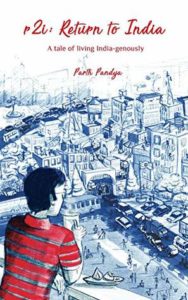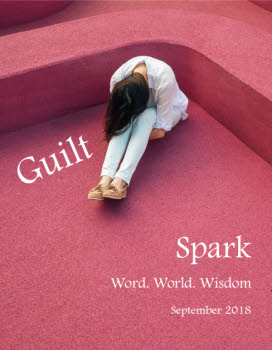by Subhashini Srinivasan
r2i: Return to India: A Tale of Living India-Genously
Publisher: Createspace Independent Publishing Platform; 1 edition (20 August 2018)
Language: English
ISBN-10: 172167277X
ISBN-13: 978-1721672776
After a point, food ceases to be just about what one eats. It becomes a creator of memories that resonate after you’ve long left the place.
A decade ago, when my brother had just washed up on the shores of the US as a newly minted graduate student, a sort of temporary madness used to seize him in the hours between 4 and 7 PM: the craving for ‘tiffin’. A frenzied search of the pantry would be made, the fridge would be ransacked; finally, after prowling around the kitchen a few times, he’d blow out a sigh of frustration and plop down on the couch with a fruit in his hand. Fresh out of college and used to the yummy pakoras, bhel, bajjis, Maggi, vegetable puffs served at BITS-Pilani canteen during the evening hours, he was flummoxed with the lack of ‘right’snack choices in the evening. Ten years of living in the US and my brother (and millions of NRIs including me) who once craved tiffin has all but forgotten the wonders of Indian short-eats and a million other small pleasures that he grew up with. We are all creatures of the present and as these simple, everyday routines — food being one of the most important — that connect to you the social and cultural fabric of a country dissolve with distance, you begin to wonder if there’s anything at all that’s relevant to you in your homeland other than the ties of blood that tug at your heartstrings. What if you are more American than Indian at heart? What if your tastes have changed unalterably? What if you don’t enjoy the things that your family in India finds very meaningful? What if the things you need to feed your soul are no more to be found in the by-lanes of Bangalore or Mumbai or Chennai? And if you do move back on an impulse, what if it turns out to be the biggest mistake you’ve ever made?
In this deeply personal and engaging memoir ‘r2i: A tale of living India-genously’, Parth Pandya attempts to answer these and other profound questions as he relocates to India after twenty years in the US and re-discovers his love of Indian street-food, the unexpected dangers (involving cake, of course) that lurk in Indian birthday parties, the joys and travails of living in a teeming metropolis and above all, the unexpected humanity and kindness that abounds in this country. This is the author’s second book on the subject of immigrant issues. The first book, “r2i dreams: For here to go?” (which I co-authored with him and Ramya Sethuraman) found the author contemplating return to India (r2i). The second book picks up right where the first one left off. On a ‘dark, wintry Seattle night in January’, he finally decides not to ‘swim in the forever tide of “what-if”’ and decides to give r2i a try:
‘“Let’s go,” I said. “I don’t want to talk about it endlessly.”’
And thus unfolds his family’s odyssey back to India: from winding up a household and packing it into a finite number of cartons to the initial shock of India to the eventual adjustment. Unsurprisingly, it is the American-born kids who adjust to India first rather than the India-born adults. Parth and Varsha find their feet slowly but surely as they find a house, hire reliable domestic help, discover the joys of cheap labour, learn to drive in the infamous Bangalore traffic, bask in the warm embrace of family and settle into the Indian work life replete with the dreaded ‘night calls’ (conference calls at night).
In some ways, this is every NRI’s story. Just before I moved back to India in 2012, I spent a lot of time online looking for information about r2i. Usually, the stories fell into one of the two extremes: people seemed to love it so much that they highly recommended it or they found that they couldn’t stand most aspects of Indian life and chose to return back to the US (r2US) within a few months or years. What makes Parth’s story unique and compelling is his nuanced takes on life in India. He makes no recommendations and doesn’t thrust his opinions on the reader. He doesn’t carry too many expectations himself. Instead, he is content to just be, savour each and every experience fully and enjoy whatever emerges out of it. He sees the good and the bad and admits that it is not so easy to slot every India experience into a neat, labelled cubbyhole. And therein lies the success of this book.
Parth touches nearly all topics relevant to a returning NRI – schooling, work, social life, family, travel, food and finance. Each of these topics is an essay on its own and that makes for easy reading. Parth’s narrative is fluid, compelling and crisp, peppered with witty observations about daily life in India. A lot of passages had me nodding my head in agreement, chuckling and laughing out loud. Recounting his visit to clear customs for his belongings, he is shown into a government office where the ‘ceiling fan moved as leisurely as Arjuna Ranatunga trying to take a run’. As someone who grew up watching that Cricketing Great run between the wickets, that had me laughing out loud. In another passage, describing the video game-like driving situation in Bangalore, where vehicles come at you left, right, towards, against, between, etc., he notes that ‘it is only a matter of great relief that no car drops on you from the top.’ As he puts it himself, ‘India, where this Parth definitely needs a Sarathy!’ And some of the more sober, sanguine observations about life, human nature also hit their mark with unerring accuracy: ‘India reminded me that there is more than one type of living possible and that continuing to live in the United States need not be the one sacrosanct way to fulfilment.’
The experience of r2i from a woman’s point of view can fill an entire tome in itself and Parth devotes a brief chapter to it. The prevalent misogyny and patriarchy prevalent in daily life are described by recounting the experiences of his wife, Varsha. I was a bit surprised as I read through the passages describing sexism and misogyny on the road. I myself have never felt discriminated against as a female driver and I swerve and cut off and honk and stop short with the best of them! But I’ve had plenty of instances where a carpenter or an electrician has refused to take instructions from me, instead, choosing to wait for the man of the house to repeat, word for word, what I said. What particularly used to infuriate me was that they’d keep smiling and nodding at me trying to keep me in good humour all the while blatantly refusing to act on my instructions. In fact, this used to happen with such alarming regularity that at one point, I totally relinquished the responsibility of dealing with these worthies to The Man Of the House.
Overall, it is a wonderful follow-up to the first book. I did wish that it had a deeper reflection on the problems that beset India outside of the Bangalore gated community world that the author inhabits. Perhaps that might be expecting too much out of a book that lays out an NRI perspective? However that may be, it is an effortless read and the author’s incisive wit and wry humour keep the pages turning. The Kindle version would’ve read better with a table of contents. It made for tough navigation when trying to look up a particular passage. The paperback has a beautiful cover designed and illustrated by Megha Vishwanath, an illustrator based out of Bangalore. When read together with the author’s first book ‘r2i dreams’, it paints a beautiful panorama of an immigrant’s journey to a far-off land and back again. One of the most iconic passages in the book (my personal favourite) describes India thus:
‘US served me my omelettes just right – no spice, but cooked to perfection. India added tomatoes and chilies and coriander and other masalas, but I couldn’t be sure that I was always going to get the omelette on time, or before the person who was behind me in the queue or if it was going to have an ingredient go a tad haywire. However, if I was willing to make my peace with these factors, the taste was fabulous.’
Ultimately, the book is a deeper reflection on identity, home, social connections and the ability of humans to make a life anywhere on this beautiful planet. Will he stay back in India forever? Will he decide to go back to the US? Watch out! There may be another book in the offing from this entertaining storyteller!






